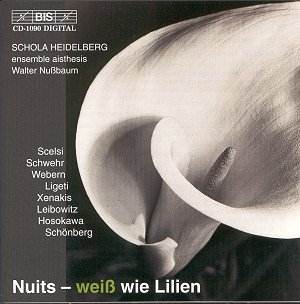
Crotchet
AmazonUK
AmazonUS |
Nuits - Weiß wie Lilien |
If you have not yet explored new European choral music, this CD is as good a starting point as any I have encountered recently. Such advanced music was conspicuous by its absence from the International Choral Competition upon which we reported for S&H recently from Rhodes.
The crack Heidelberg choir is equal to all the demands of composers living and long dead - the earliest items by Webern sounding as 'modern' as any of the others. The moving 12-tone setting of Schönberg's sung and spoken prayer in Hebrew, De profundis (1950) should hold no terrors, built up as it is mainly from thirds and tritones. Toshio Hosokawa's Ave Maria (1991) for sixteen voices introduces pre-recorded breathing and its arched form starts and ends with a triad B-Eb-A. Giacinto Scelsi's Tre canti sacri (1958) explore individual notes in quarter-tone and articulatory embellishments, whereas his later TKRDG invents a vocal-instrumental language supported by guitar and three percussionists.
Less familiar names are those of René Leibowitz (Blake settings in not-quite perfect English) and Cornelius Schwehr whose macabre, wordless deutsche tänze (1990) deals with a senseless execution under Nazism.
György Ligeti in Lux úterna (1966) suggests bright light with micropolyphony and cluster harmony, and Iannis Xenakis brought many newly invented sounds into his (1968) Nuits. Webern's characteristically brief yet complex pieces (1925/26) offer tonal respite from mainly a capella choral singing with their exotic instrumental accompaniments. His vocal angularities are negotiated with confidence by the choir and by solo soprano Anja Tilch, whose rather backward placing in relation to guitar and clarinet is about my only small criticism of a splendid production, with full documentation and all words given with translations.
Peter Grahame Woolf